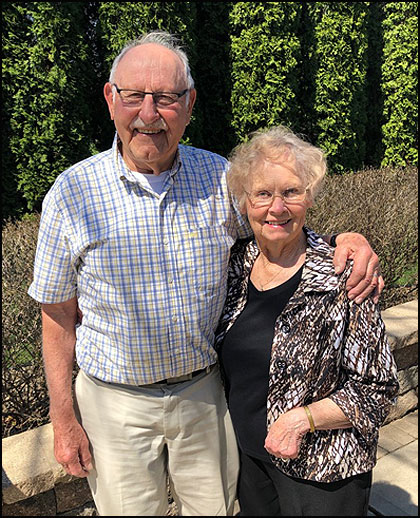



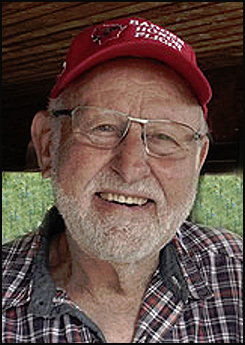
Boot Hill, Tombstone, AZ.
The sharp report of Doc Holliday's shotgun blast echoed across the OK Corral and down Front Street of
Tombstone, AZ.
Tom McLaury lay dying, holding his tunic open to show Doc Holliday he was unarmed, with 12
pellet holes from Holliday's shotgun blast in his side! 30 seconds, 30 shots! The Gunfight at the OK Corral
was over. Dead or dying were Tom McLaury, Frank McLaury and Billy Clanton. Tom and Frank were Eldon's
Grandfather's half brothers.
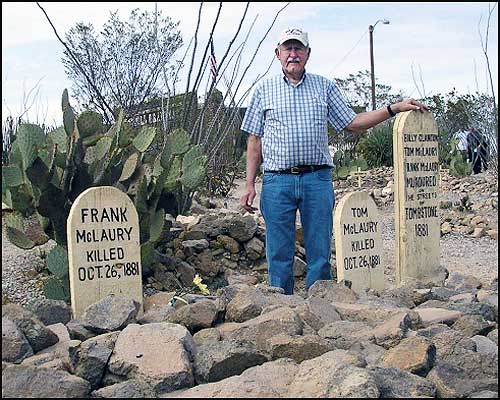
Eldon is a depression era kid, born September 22, 1933 in a sharecropper's farm house in NE Iowa. The family
moved several times before purchasing and settling on a northeast Iowa farm four miles northwest of Fairbank, Bremer County, Iowa.
Eldon attended a Country School (10 - 13 students) thru 8th grade then Fairbank Public High School,
graduating in 1951 at 17.
In December of 1953, Eldon received a letter from the Draft Board: "Your friends and
neighbors have selected you..."! He was drafted into the Army, March 3, 1954.
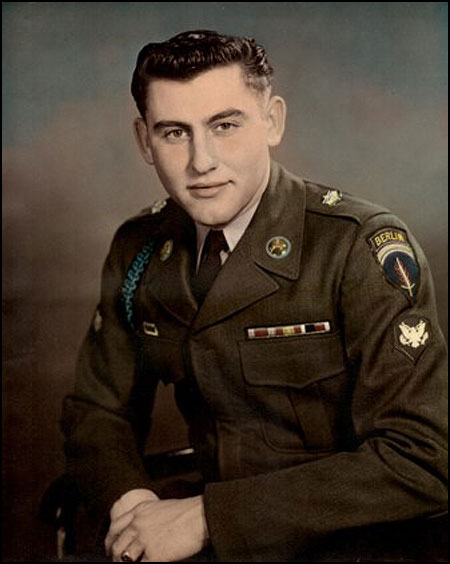
After boot camp, radio
training (Morse Code) and 30 days leave to include opening of Iowa's November pheasant season, he reported
to Ft. Dix, N.J. and shipped overseas.
After 10 turbulent days at seas on a 571 foot ship and stairwell detail,
where troops got sick, they arrived at Bremerhaven, Germany. Eldon was assigned to Berlin, some 110 miles
behind the Russian Iron Curtain in Russian Territory. He left Frankfort via train at 7:30 pm, according to a Russian dictate of no
daytime train travel, and arrived in Berlin at 5:30am after ten hours, many stops with 'jack booted, burp gun
carrying Russian soldiers' marching by train windows at each stop.
In Berlin, Eldon was assigned personnel
duties including responsibility for service records of troops in A, B, C, & D Companies. No guard, no KP, 8 to 5 daily
Monday thru Friday.

Berlin was a divided city with four sectors: American, British, French and Russian. The Russian Sector was post
WW II. Bullet holes in street signs, bombed buildings in shambles, piles of rubble everywhere, the
"Reichstag", a former German Headquarters, a burned out shell!
After 15 months Eldon was flown (4 engine plane)
back to the USA and discharged February 11. Home that night after 9 days. Better than 10 days at sea!
Back home, re-quaintances, parties and dances ruled. Eldon met and married Virginia Lamphier, August 31,
1956. They celebrated their 67th wedding anniversary August 31, 2023. Sixty seven years, 3 sons, 9 grand
children and a most exciting life adventure. Virginia, Eldon's encouragement, confidant, support!
After several 'dead end' jobs, at age 26 and with his wife's encouragement, in 1958 he enrolled into Iowa State Teacher's
college, now the University of Northern Iowa.

After 2 years, he knew he could not be a teacher. A posting for a
USFWS Refuge Manager changed his goals to Wildlife Management. The University of Montana, Missoula had low
enrollment, low tuition, and was a good school. In September of 1960, the McLaurys moved to Missoula and he enrolled in the
University's Wildlife program -Wildlife Technology.
National Bison Range, Montana
In February, 1961, Eldon received a US Fish & Wildlife Service
student trainee summer appointment to the National Bison Range in Montana.
A totally new experience of 8 to 5, five days per week. Better than farming!
Duties included tour guide, bison
studies, herd movement/thunder storms, meadow irrigation, road and building maintenance, fence repair,
waterfowl surveys, duck banding on satellite refuges, campground cleanup and raising an orphaned bison
female calf, Jezebel. During the summer, maintenance staff considered the purchase of new horse for the fall
bison round up.
They encouraged Eldon to ride the saddled horse in the corral. He grabbed the reins, stuck a foot
into the stirrup, set his butt in the saddle and 'almost' a foot in the other stirrup. The horse bucked, and to the amusement of the MM crew, he
sailed through the air to land unhurt on his hinder!
They bought the horse and he gained an appointment to the US Fish & Wildlife Service (USFWS)
Range Survey Crew, Lakeview, Oregon
Eldon graduated Phi Sigma Honor Society from the University of Montana, Wildlife Technology, May of 1962
and began his 35 year career (2 years Military Service) in June on the Range Survey Crew, Lakeview, OR.
Surveys by ocular reconnaissance, walking the area and estimating the percentage of rangeland vegetative cover and
percentage densities of grass, forbs and shrubs. Surveys were completed on Malheur NW Refuge, 181,500 acres,
and Sheldon National Wildlife Refuge, 535,000 acres. Data collected was used to determine deer, antelope and
livestock carrying capacities.
Eldon received Federal Law Enforcement authority and was detailed to Klamath
Basin Refuge Complex, Tule Lake, CA. for the 1963 and 1964 waterfowl seasons encountering 5,000 +/- hunters a day. In
October of 1964 he accepted the biologist position at Red Rock Lakes NW Refuge (40,000 acres) in Monida,
Montana, an opportunity to work with Trumpeter Swans and fulfill a lifelong goal.
Red Rock Lakes NW Refuge, Montana
The adventure continued as Eldon, Virginia and their 2 sons, age 3 months and 2 1/2 yrs, arrived at refuge headquarters of the
40,000 acre Trumpeter Swan Refuge on Dec 6, 1964. The headquarters and their home were 28.5 miles of dirt gravel road east
from Monida/Monida Pass then 80 miles South to Idaho Falls, Idaho. Both the headquarters and their home were at 7,000 feet
of elevation in the Centennial Valley, adjacent to the Centennial Mountains, ranging up to 10,000 ft, and the Continental Divide.
Mountain living!!
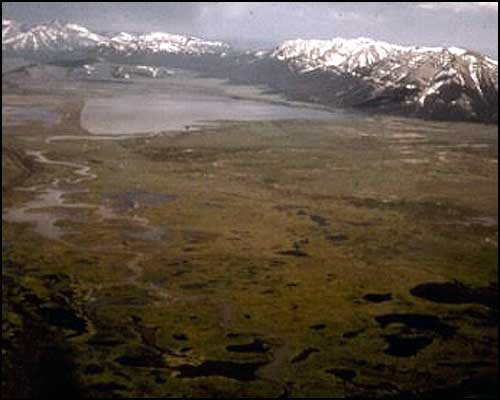
They were advised to "stock up" on groceries and supplies for winter living! They did,
including a book of "Dr. Spock", home medical guide which proved invaluable. They were snowed in their first winter from January 6 to April 15, surviving and enjoying the circumstances.
Winter feeding overwintering Trumpeters on two 48 degree spring fed ponds 16 miles up the valley was a
twice a week winter activity. Wheat was scattered from a rowboat into 2 to 3 feet of water in the ponds. Air
temperatures varied from 40 above (a Chinook) to 42 below zero. Every feeding day was an adventure. On Eldon's first feeding trip
he traveled by weasel, a tracked vehicle with a top speed of 15 MPH, the 16 miles up the valley. As he drove, he noticed a 'halo'
around the top of adjent Baldy Mountain, strange!
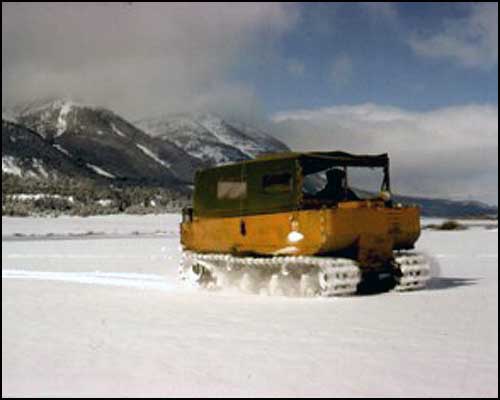
After feeding the swans and stopping to visit an
overwintering rancher he started back to headquarters. It was snowing and near dark. As he rounded a protective
hillside he encountered a fierce blizzard. The single headlight was useless, visibility only 6 to 8 ft. Travel was
possible only by watching fence post tops from the lea side of the road as the other person drove. Two plus hours
and 6+/- miles they arrived at headquarters!
On December 29, with Virginia and the boys, he drove a chained up 4 wheel drive 'Willys'
jeep the 28.5 miles to Monida and their car. The goal was to get to Missoula and friends to celebrate New Year's. They returned
to Monida January 2 in a blizzard with the road closed and no travel allowed. After two nights in Dillon, Montana they returned to Monida, still
blizzarding, and still no travel recommended. They overnighted at the Monida Hotel and on January 6th, at 6:30pm, word came they could leave! Eldon, Ginny, the two boys all in the Willys jeep along and 5 other vehicles started the 28.5 mile journey to
headquarters. Six miles later, they caught up with two dozers and a road patrol clearing the road.
At 7:30am the next morning, thirteen hours later through fences and over snow blown hillsides they arrived at headquarters.
They had survived and enjoyed the circumstances, Mountain Living!
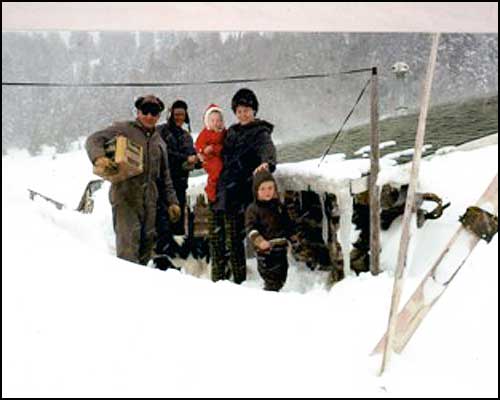
Mail came 3 days a week via ski plane, no set pattern, even on Sundays. They fed swans twice a week, on good
days only, no halos on Baldy Mountain. Planning, annual reports, budgeting, equipment maintenance and keeping warm!
Eldon attended first USFWS Basic Refuge Manager Training Course in Arden Hills, MN. The family trip to Monida was in a
Bombardier snow machine with an outside temperature of minus 30 degrees! The road opened April 15, ice out was May 1 and field activities started including
Trumpeter Swan nest site mapping, nest success/brood counts; biweekly aerial/ ground waterfowl counts,
Greater Sandhill Crane trend counts, fall moose and antelope surveys, Aquatic plant surveys--species
densities. September activities included annual aerial Tri State (Idaho, Wyoming, Montana) Trumpeter Swan population production survey.
Initiated "winter" aerial Trumpeter Swan survey over the same area. Trumpeter Swan movement initiated Trumpeter Swan Migration Study to determine if and where Trumpeters migrate from Red Rock
Lakes. With Banding Office approval captured, banded and neck collared 100 trumpeters on Upper Red Rock
Lake, applying expandable plastic neck collars 2 1/2 inches high, 2 in inside diameter. Red collars to males, green
to females per Banding Office approval.
Nevada marked whistling swans with the same color neck collars.
The study result was conflicting results and the study was abandoned.
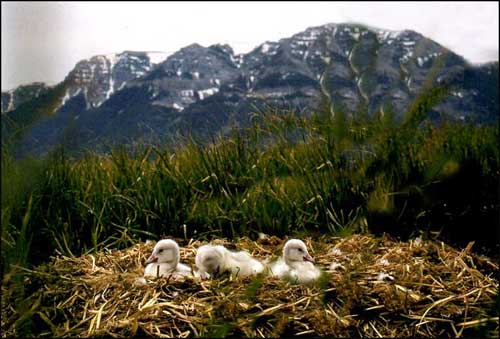
Eldon and Ginny's third son was born in Idaho Falls, Idaho on February 23, 1966.
Plans were to stay in Idaho Falls a week before the March 7 forecasted birth. But a midnight experience with labor spasms 2 minutes apart
changed the program. Fortunately, the county opened the road to Monida 2 days earlier. Eldon woke the
neighboring rancher to stay with the boys and they departed for Monida. Ginny endured a bouncing ride in
the chained up 4 wheel drive Willys Jeep pickup over the 28.5 miles to Monida and an 80 mile ride their car to
Idaho Falls. He was not a mid wife! Their third son arrived at 3:00 pm February 23, 1966! Mountain living is just
full of surprises!
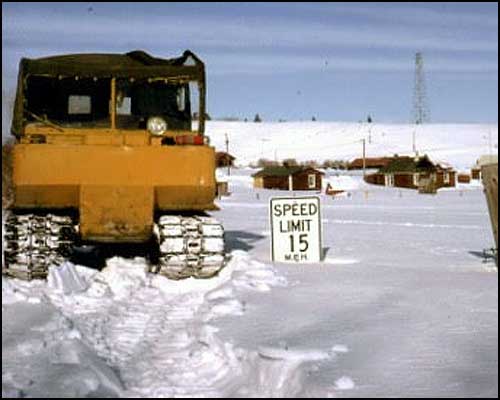
In February, 1967, Eldon accepted a transfer and promotion to Refuge Biologist, Malheur NW Refuge (181,800 acres), 32
miles South of Burns, Oregon with the move scheduled for April 3. The road opened to Monida in late March.
Malheur National Wildlife Refuge
from April 1967 - September, 1974
On April 7, 1967 Eldon and his son Loren stopped at Wright's Point, some 10 miles south of Burns, Oregon. The
desolate southern view over sagebrush and salt flats included the west side of Malheur Lake and Harney
Lake, a dry alkaline lake bed. Malheur NW Refuge headquarters were visible some 20 miles distant. The refuge and a
small 2 bedroom house 32 miles South of Burns, Oregon would be their home for the next 7 1/2 years. He wondered
why after living with scenic views of the Centennial Moutains and studying Trumpeter Swans at Red Rock Lakes.
But there would be new opportunities, challenges, experiences and a country school for the boys.
A bit of background: Malheur NW Refuge is a wildlife oasis in Oregon's High Desert country south of Burns,
Oregon. The 181,800 acre refuge, in the shape of a lopsided "T". It is approximately 40 miles long and 38 miles wide
and is in a "closed basin" watershed that depends on snow melt and runoff from the Steens Mountains to the
southeast and the Blue Mountains to the north. Annual Precipitation is only 5 inches.
Refuge habitat, especially the 60,000 acre
Malheur Lake, is one of the most important areas for migratory waterfowl and waterbirds in the Pacific
Flyway. The Refuge is strategically located between northern nesting grounds and southern wintering areas.
Spring and fall migrant waterfowl populations of 500,000 ducks, 200,000 geese and 15,000 swans including a
small population of Trumpeter Swans that had been recorded. Many species of colonial birds nest on Malheur
Lake, including the most northwesterly nesting population of Franklin's gulls. Malheur Lake itself was established
as a migratory bird "sanctuary" in 1903, to protect colonial nesting birds from plume hunters.
The habitat varies from Malheur Lake's 60,000 acres, Harney Lake's 30,000 acres, alkali playa and sump from Malheur Lake
overflow, and 91,000 acres of irrigated meadows, marshes, ponds and adjent sagebrush uplands and
basaltic rims. Melting snow packs from Steens Mountain (up to 10,000 ft) provide water to ponds and
meadows in the Blitzen Valley (south of the Headquarters) and to Malheur Lake. Snow melt from the Blue Mountains to the
north provide waters to the Double O west of headquarters and to Malheur Lake via the Silvies River north of head
quarters. Overflow from Malheur Lake flows west into Harney Lake, a barren 30,000 acre alkaline basin and
watershed sump.
Malheur Lake varies from dry to 60,000 acres of water interspersed with cattail and hardstem bullrush
islands with a maximum depth of five feet. Open water areas produce expansive stands of Sago pondweed producing
up to one pound of wet vegetation per square foot, when carp populations are controlled. Islands and expansive
stands of cattail and/or hard step bulrush provide nesting habitat for hundreds of colonial nesting species.
Eldon's charge and responsibilities as refuge wildlife biologist were for all aspects of wildlife management
and to write a Refuge Wildife Inventory Plan to record and document annual wildlife use on the 181,800 acre
refuge, a plan in the making since 1936. GOAL FULFILLED, Eldon wrote the plan 'after 7 years of field
investigation'. The plan is on file at Refuge headquarters.
Highlights while at Malheur Lake include waterfowl and breeding pair counts, 202 miles of aerial, vehicular, and walking surveys, 4,000 to
48,000+/- ducks produced annually. Colonial Nesting Birds--aerial/airboat surveys Malheur Lake: hundreds of
blk crowed night herons, GB herons, snowy and great egrets, white pelicans, cormorants, white fed ibis, Franklin,
California, Ring-billed gulls. Observations of California Gulls snatching and swallowing young Great Blue herons!
Other activities included conducting wildlife programs and refuge tours for schools, colleges and university students
almost daily from February 15 to May 15, coordinating graduate student wildlife studies, managing a waterfowl hunting
program on 15,000 acres of Malheur Lake. Also included in his duties were rescuing lost hunters, coordinating Blitzen Valley upland bird
hunts - pheasants, valley and mountain quail, deer archery hunt and coordinating the Malheur Lake muskrat
trapping program. He failed to recall the number of muskrat houses counted in 1973, but trappers removed
20,000 muskrats in January and February. But that was not enough harvesting, there was a major die off that spring.
Carp, the 'Queen of the Game Fish' per Izaak Walton were introduced into Malheur Lake (closed
basin) watershed in the mid 1930s. Low snow pack in 1968 and by October, Malheur Lake dried to 3,500+/- acres,
concentrating carp in approximately 900 lake acres at mouth of Blitzen River. In October, a Carp Control
Program using Pro- Noxfish drip stations on 59 miles of Blitzen River and aerial application on 900+/- acres of
Malheur Lake killed 190,000 - 240,000 carp averaging 5.5 lbs. A coyote 'smorgasbord'! Four years
later (1972), Malheur Lake filled to 60,000 acres and produced some 16,500 acres of 95% Sago pondweed.
Waterfowl populations exceeded 250,000 ducks; among them, 35,000 canvasbacks. Malheur Lake
overflowed to fill 30,000 acres. Harney Lake hosted approximately 35,000 shoveler ducks likely most of the Pacific
Flyway shovelers. Hundreds of snow geese also visited Malheur Lake. One snow goose banded by the Russians
on Wrangel Island did not make it to the wintering grounds! Tough to eat too. The six bird daily duck hunter bag
could include six Canvasbks. Eldon harvested six Canvasbks on two occasions but never got a photo of the event.
Banding--Ducks and Sandhill Cranes: "cannon netting" was converted to "rocket netting" using skirted nets to
capture and band ducks and Greater Sandhill Cranes. Eldon designed metal rocket launching stands after
bk blast destroyed wooden stands holding the rockets. Adjustable angle ground level stands for capturing
waterfowl and 30 inch stands for capturing Greater Sandhill Cranes. The metal stands withstood rocket back blast
for net projection. Eldon received the 1969 Oregon Chapter, Wildlife Society "R.E. Dimick" award for netting
procedures.
The "rocket netting" slide program became a teaching tool for wildlife studies at Oregon
State University, Corvallis, Oregon. Eldon also demonstrated rocket netting procedures to some 7,000 +/- Boy
Scouts at the 1973 Boy Scout Jamboree, Camp Farragut, Idaho.
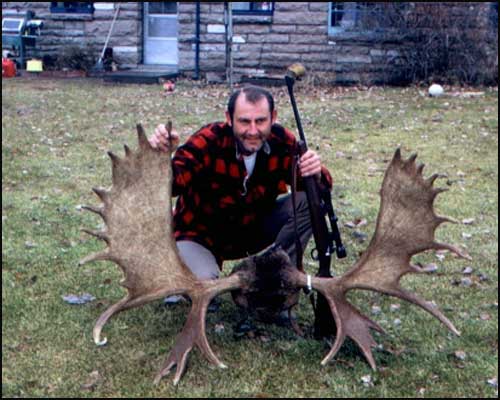
As an Aerial Wildlife Observer, Eldon spent over 75+ hours annually on waterfowl and muskrat house count flights. USFWS demanded
aerial observer flight training to land a plane in event of pilot problems. After 9 hours of training, Eldon flew a
Cessna 150 aircraft for a 15 minute solo flight. His shirt wet with sweat from the elbows to waist. Exciting!
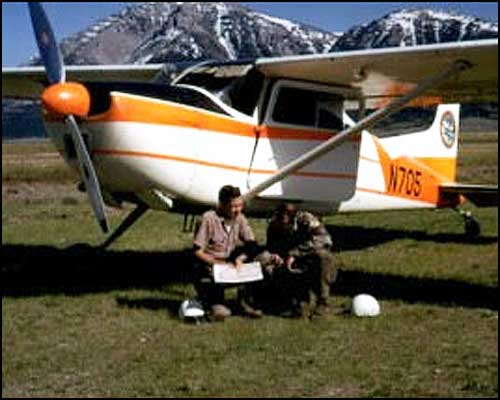
After 7 1/2 yrs of biological wonder, lost in the airboat on Malheur Lake, sinking the airboat then refloating the
airboat and returning to dock, hundreds of miles of hip boot surveys and census and 7 million mosquito
bites morning, noon and night from June 1 - August 15, and the fact the refuge manager would not
authorize the McLaurys moving to a town with a public school, Eldon decided to transfer. His boys, after the 8th grade, would have been required to go to a
boarding school, 35 miles distant! No way.
Sheldon - Harat Mountain - Modoc NW Refuge Complex
September 19974 - July, 1978
Eldon transferred to Lakeview, Oregon, assumming the duties of assistant
manager, of the Sheldon, Hart Mountain and Modoc Refuge Complex from September 1974 - July, 1978.
In Lakeview, Oregon, the boys went to public school. No boarding school.
He assumed Assistant Manager responsibilities of the 813,000 acre refuge complex, headquartered in Lakeview, Oregon; Sheldon National
Antelope Refuge and Range, NW Nevada-535,000 acres, 100+ miles West of Lakeview; the 272,000 acre Hart Mountain Antelope Refuge located 60 miles NE of Lakeview, and Modoc NW Refuge, Alturas, CA, 60 miles south of
Lakeview.
Sheldon and Hart Mountain habitat included expansive stands of sage brush, bitterbrush and grassy
meadows interspersed among basaltic ridges with scattered springs: ideal habitat for antelope, mule deer, big
horn sheep, sage grouse, and scattered bands of "free roaming" horses and burros. Habitat mnanagement included
prescribed burning for sagebrush control, "spring development" for wildlife water and preferred for rotation
grazing for bitterbrush growth control and grassland management!
Ever increasing numbers of "free roaming" horses and burros on Sheldon and Hart Mountain overgrazed
vegetation and concentrated on free flowing springs, reducing or eliminating and often contaminating waters
for wildlife. Spring enclosures reduced the problem, but horse and burro round up and capture solved the
problem.
Captured horses and burros were sold at Auction in Sramento, CA.
Limited permit trophy antelope, bighorn sheep and mule deer hunts were conducted on Hart Mountain and
controlled Trophy Antelope hunts on Sheldon. Permit holders were required to attend pre-season hunter
orientation programs emphasizing trophy harvest--16+ inch antelope horns and 3/4 + curl rams; mule deer
permit holders limited to-4 point (one side) antlers. Hunter success was high. Modoc Refuge was open to
waterfowl hunting.
In August 1978, Eldon applied for and was selected Manager of the Detroit Lakes Wetland Management District,
in Detroit Lakes, Minnesota.
Detroit Lakes Wetland Management District
June 1978 - August, 1981
The challenge was managing 31,000 acres of Waterfowl Production Areas (WPAS) and 28,000 easement acres
scattered in five northwestern Minnesota counties.
Activities included land aquisition from willing sellers, with
aquisition proposals presented to County Commissioners for approval. Some were denied because the "Government
did not control their thistles". Properties approved for purchase (WPA'S) were converted to wildlife habitat
emphasizing duck production included wetland restoration, seeding cropland to native prairie grasses,
boundary fencing and posting. WPA management included prescribed burning, boundary fencing and
resolving boundary violations, especially cropland trespass on unfenced WPAs. Fencing resolved the
agricultural trespass problem.
Drainage of wetlands under perpetual easement was a continual problem requiring annual aerial or ground checks for wetland drainage violations. Violations observed required land owner contact, often challenging dogs vs legs, drainage denial, and then land owner failure to restore the
wetland after agreeing. Resolving the issue was a Law Enforcement four day "sting operation" by six Law Enforecement officers "paired" for
safety reasons to contact the 62 violators beginning at 5:00 AM. A highlight was escorting an easement
violator from the S & H sugar plant in Fargo, N.D. in full law enforcement regalia -- guns and all.
Eldon gained
resolution commitments from 55 violators. The remaining 7 were remanded to federal Court which was another exciting experience. He learned to never cite trite statements in field notes that may become court records, ie: wry grin. The
judge asked for his definition and Eldon replied 'screwed the government again'!
After 3 years at Detroit Lakes he was offered the Wildlife Assistance position in Wisconsin. He accepted the position and served in the Wisconsin Wildlife Assistance Office, located in Madison.
Wisconsin Wildlife Assistance Office, Madison, Wisconsin
August, 1981 - May, 1994
Along with the position came new tasks, new challenges, new programs: USFWS Coordinator with Wisconsin Dept of Natural Resources--
Wisconsin Waterfowl Production Areas, Migratory Bird Animal Damage Control, wildlife programs with
Natural Resources Service (SCS), Farm Services Agency (ASCS), USDA Rural Development (FmHA),
Ft.McCoy (USArmy), Indian Reservations (11) and private lands conservation organizations.
A highlight and his most enjoyable dutiy was the Wisconsin Waterfowl Production (WPA) Program, a wildlife program
unique in the United States. Under WPA guidelines, USFWS provided aquisition funds and DNR realtors
purchased lands and waters from willing sellers and field resource personnel restored and managed the lands
and waters for wildlife.
A magnificently successful program benefitting wildlife resources of Wisconsin and the
Nation. A program so successful that in 1991, because of WI DNR staff work overload, WI DNR personnel
requested withdrawl from the program. USFWS resolution was the establishment of two Wetland Management
Districts: Leopold and St. Croix. The change ended one of the most successful State and Federal coordination
programs benefitting waterfowl and wildlife in the United States. Eldon felt it was a privilege to have worked with this most
successful wildlife program!
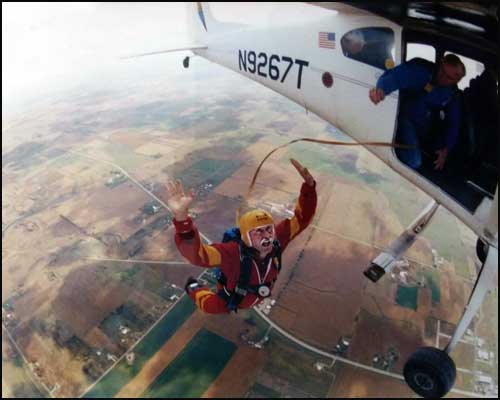
Other duties: included resolution of Animal Damage by Migratory Species including woodpeckers/homes, owls/pheasant
farms, heron and gulls/Fish Hatcheries, owls/rabbits at beagle training sites, blackbirds/sweet corn, owls/
game farms--the list is endless. He felt it was sort of like Wildlife Management in reverse!
The 1985 Farm Bill: legislated/delegated multiple conservation responsibilities to US Fish & Wildlife Service, ie: assist
agricultural agencies--SCS, FmHA, & ASCS- w/wetland ID, minimal affect ie: ag activities in wetlands,
commenced rulings ie: draining wetlands, swampbuster (draining wetlands). Violations influenced farmer
subsidy payments. Most cases were resolved amicably, but three were not. Involving hundreds of thousands of dollars, one
resulted in a life threatening statement. The three violations were pardoned in 1992 by the incoming President and the funds
released.
Eldon established the USFWS Private Lands Program to address and coordinate USFWS responsibilities in the 1985
and subsequent Farm Bills with other conservation agencies. ie: together, more can be done for the wetland
and wildlife resource. Among those responsibilities was review of 500+/- Wisconsin farms lost to the
government---Farmers Home Administration--lender of last resort, for presence of wetlands and transfer of
select properties to other government agencies.
The farms were reviewed and 15,000+ wetland acres placed under perpetual easement. In addition, 11 farms were transferred to other agencies:, 4 farms--511 acres
transferred to WI DNR, 1--194 acres to WI DOT, 1 - 324 acres to US Forest Service - wolf habitat and 5,520
acres to USFWS--WPAs. The remaining farms were sold on the county courthouse steps.
Wetland Restoration Celebration--August 5, 1993--recognized interagency and Conservation personnel
restoring 2000+ Wisconsin wetlands and 10,000 wetlands restored in the upper midwest. "Partnership" was
the word of the day, with 250 + Interagency, Conservation and public folks attending the celebration at the
wetland restoration site on the Steve and Anna Blue Farm, Ozaukee Co, Wisconsin
Eldon, received "Certificates of Appreciation" from State Offices of Wisconsin DNR, Soil Conservation Service,
Agriculture Stabilization and Conversation Service, & Farmers Home Administration for "Outstanding"
Interagency Cooperation" promoting the conservation and restoration of Wisconsin Natural Resources!
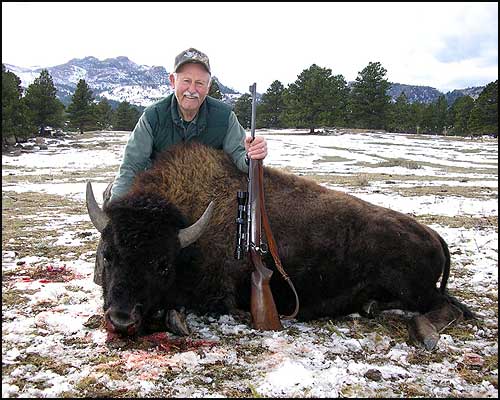
Retired
May 4, 1994
On May 4, 1994 Eldon retired, one month short of 33 years with the USFWS (35 yrs of Federal Service).
Retirement culminated a fantastic adventure once thought impossible, an adventure taking the McLaurys from the
farm fields of NE Iowa to Madison, Wisconsin, via mountains, deserts, the ocean of the Pacific NW, lakes of northern
Minnesota, tundra and wetlands along Hudson Bay East of Churchill and the hustle of Washington D.C. A most exciting, challenging and rewarding career!
A career made possible with his understanding and supportive wife, Ginny!
Post Retirement: Wisconsin DNR, Wisconsin Waterfowl Association--Board of Directors
Travel: London, Paris, Hawaii, past Christmas Island, Tahiti, Moorea.
Two month 11,418 mile camper adventure through the Pacific NW, British Columbia, Yukon, NW Territories,
Alaska-Anchorage, Homer, North across Yukon River, past "Living Good" ? :) - he saw an outhouse from the Haul
Road, Fairbanks, Chicken, Dawson, Alberta, Manitoba and home to Madison.
Smoking Pipe with the Nez Perce on the Banks of the Yellowstone River. An annnual celebratory event by the Nez Perce Indians recognizing their crossing of the Yellowstone River while being pursued by the US Army. All Veterans in attendance were invited to participate and smoke the “pipe” with the Indians.
Five day “Float Trip 55 miles down the Wild and Scenic Oywhee River(4 Class IV rapids) from Burns Junction to Owyhee Reservoir!
A LIFE TIME OF CHALLENGE, OF SUCCESS, OF BLESSING!
